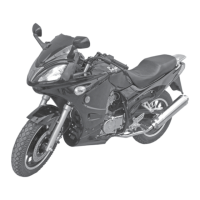
Do you have a question about the Baja motorsports BV250 and is the answer not in the manual?
| Brand | Baja motorsports |
|---|---|
| Model | BV250 |
| Category | Motorcycle |
| Language | English |
Explains warning categories like Danger, Caution, and Warning.
Refers to important information labels located on the motorcycle.
Details coverage period, conditions, and customer service contact.
Lists circumstances that will invalidate the warranty coverage.
Emphasizes the importance of helmets, eye protection, and proper clothing.
Advises on gaining experience and understanding before riding.
Advice on being visible, riding within limits, and avoiding impairment.
Highlights the importance of keeping the motorcycle in safe operating condition.
Highlights critical safety warnings and instructions on motorcycle labels.
Specifies recommended cold tire pressures for the front and rear tires.
Identifies major parts located on the motorcycle's body and frame.
Identifies components and controls situated on the handlebars.
Details various controls, switches, and instrument displays on the handlebar.
Describes the function of the speedometer and odometer.
Explains the engine RPM meter and fuel level gauge.
Explains how to operate the fuel valve to control gasoline flow.
Describes the function of the choke and ignition switches.
Details the ignition switch for starting, stopping, and steering lock.
Explains the operation of the engine start and emergency stop switches.
Describes headlight dimmer, turn signals, and horn operation.
Explains how to reset the tripmeter to zero.
Recommends reading the manual and understanding controls before the first ride.
Stresses physical health, protective gear for rider and passenger, and sobriety.
Lists critical checks for brakes, throttle, lights, chain, and tires before riding.
Details checks for carrying passengers or cargo, including load limits.
Specifies the total weight capacity and maximum cargo weight.
Advises on securing, balancing, and positioning cargo for stability.
Step-by-step guide for starting the motorcycle engine.
Procedure for starting the engine in typical temperature ranges.
Procedures for starting the engine in high and low ambient temperatures.
Steps to take if the engine becomes flooded with gasoline.
Explains clutch operation and the sequence of gears.
Provides advice for new riders on learning to shift gears smoothly.
Guidance on optimal gear selection for speed and engine RPM management.
Covers front and rear brake usage for slowing down and stopping.
Warns against improper braking during turns or on steep grades.
Covers parking on level ground, hills, and using the side stand.
Details using the steering lock and general security tips.
Outlines pre-ride inspection and scheduled maintenance intervals.
Stresses the owner's role in performing and documenting maintenance.
Lists critical safety rules to follow when performing maintenance or repairs.
Details routine checks for tires, fluids, lights, drive chain, and more.
Explains how to use the maintenance schedule and important usage notes.
Details maintenance items and intervals for emission control components.
Details maintenance items and intervals for chassis and other parts.
Specifies unleaded fuel with octane 86 or higher as recommended.
States the total fuel tank capacity including the reserve.
Step-by-step guide for safely adding fuel to the motorcycle.
Explains the role of engine oil in prolonging engine life and performance.
Lists API classification and viscosity grades for recommended engine oil.
Procedure for checking the oil level and adding oil if necessary.
Continues the procedure for checking and adding engine oil.
Outlines the process for draining and refilling engine oil.
Details how to safely drain old engine oil and proper disposal.
Details filling with new oil, torque specifications, and leak checks.
Covers removal, cleaning, and replacement of the air filter element.
Advice on servicing the crankcase breather, especially in dusty or wet conditions.
How to inspect and adjust the throttle grip's free play.
Explains how to check and adjust clutch free play for smooth engagement.
Details the procedure for adjusting clutch free play using the upper adjuster.
Details the procedure for adjusting clutch free play using the lower adjuster.
Step-by-step guide to setting the engine's idle speed.
Specifies the correct spark plug type and part number.
Procedure for removing, inspecting, gapping, and installing spark plugs.
Explains front brake operation, fluid type, and level inspection.
Describes how to check the brake fluid level and what it indicates.
Checks for leaks, loose fittings, and damage to fluid lines.
How to inspect front brake pad wear using the wear indicator mark.
Inspection and adjustment procedure for the rear brake pedal's free play.
How to check rear brake shoe wear using the external indicator.
Specifies correct cold tire pressures for front and rear tires.
Details how to inspect tires for damage and tread wear limits.
Advises against tire repair and outlines replacement procedures.
Warns against using radial or car tires due to stability and handling risks.
Details how to check chain slack, kinks, and overall condition.
How to inspect sprocket teeth for excessive wear or damage.
Details how to adjust the drive chain slack for proper tension.
Covers axle nut torque, alignment checks, and final adjustment.
Explains lubrication frequency, method, and recommended lubricant.
Notes that chain removal/replacement is recommended for a Service Center.
Guidance for storing the battery long-term, including charging advice.
Notes on cap strip removal and the need for frequent charging.
Crucial warnings about acid hazards, explosion risks, and handling precautions.
Steps for safely removing and installing the motorcycle battery.
Recommends trickle chargers and warns against using automotive chargers.
Advice on cleaning the motorcycle using mild detergents and proper methods.
Identifies where to find the frame (VIN) and engine serial numbers.
Provides overall length, width, height, wheelbase, and dry weight.
Lists fuel type, capacities, engine oil, and drive chain lubricant requirements.
Details engine displacement, compression ratio, and gear ratios.
Lists recommended tire sizes and cold tire pressures.
Provides battery voltage/type and bulb wattages for lights.
Lists the rating for the main fuse.
Outlines owner's rights, distributor's obligations, and warranty period.
Details the owner's duty to perform and record maintenance.
Specifies where repairs are covered and conditions for denial.
Lists items and conditions explicitly not covered by the warranty.
Defines the extent of the distributor's liability and warranty disclaimers.
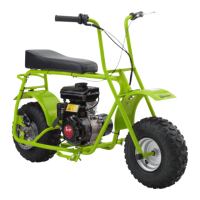
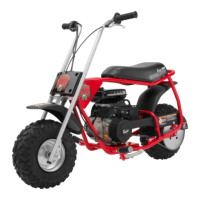

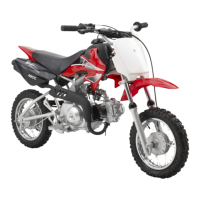
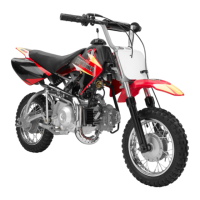
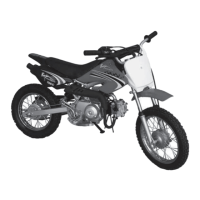
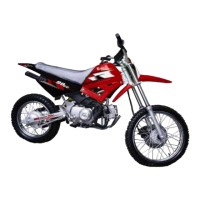
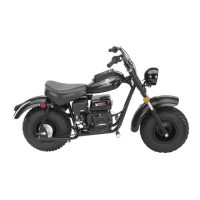
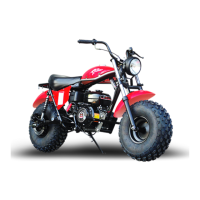
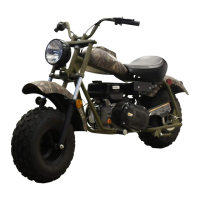
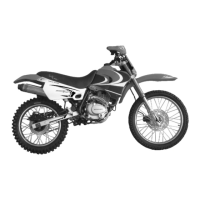
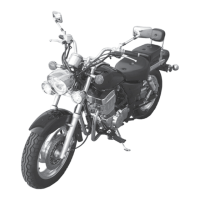
